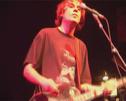The Eternal is Sonic Youth’s 2009 celebration of newfound freedom. After many years signed to an ever precarious corporate label, the band has been liberated and is releasing this CD with their friends at Matador. Inspirations ran high in preparation for the recording. Abandoning the time tested routine of writing and rehearsing a cycle of songs in one time period, SY changed tactics and would compose two to three tracks one weekend and record them the following weekend. After a solid month they had a dozen killers.
The writing took place in the Ecstatic Peace Folk + Cinema Basement in Northampton, MA and in the bands own Echo Canyon West in Hoboken, NJ. All recordings were done at Echo Canyon West with John Agnello at the board and Aaron Mullan in full assist. Agnello and band mixed the monster at Water Music in Hoboken. Greg Calbi mastered it beautifully at Sterling Sound in NYC.
Twelve tunes that are a fireworks display of Sonic Youth touchstones. From the primal no wave attack of its earliest days, to the radical chording and song structures of its 90s period, to the more focused and contemporary explorations of the last five years.
Sacred Trickster (2:10) – Out-of-the gate hardcore matinee track with Kim singing salutes to French painter Yves Klein and Western Massachusetts noise artist Noise Nomads.
Anti-Orgasm (6:08) – Inspired by the story of Berlin 60s model/activist Uschi Obermeier and the gang at Kommune 1. Free love, dominance and submission, and other political states-of-confusion.
Leaky Lifeboat (for Gregory Corso)(3:32) – The NYC beat poet Gregory Corso once referred to life on Earth as a leaky lifeboat. This tune expounds on this rumination.
Antenna (6:13) – Melodious ode to fleeting fantasy and unresolved desire with the sound of two analogue radios communicating the emotional action.
What We Know (3:54) – Charging forth with a riff in reference to Sonic's Rendezvous Band, Lee sings a triptych to identity and unity.
Calming the Snake (3:35) – One of the first tracks written, musical references to the Dead C, the MC5 and Neu. Kim musing on visions of Death in painting.
Poison Arrow (3:43) – Dedicated to the lust groove of Kevin Ayers where thoughts of love as pretty poison rejoice in surrealist deliverance.
Malibu Gas Station (5:39) – An ode to the flash moment of the camera as you knowingly step from your SUV sans panties.
Thunderclap for Bobby Pyn (2:38) – Flashing back to a wishful existence in the original Masque basement on N. Cherokee in Hollywood, crashing through lawns and garbage cans en route to the Canterbury/Disgraceland to jump up and down on beds with Helen Killer, Mary Rat and Trudi.
No Way (3:52) – First song written for the album, with a nod to The Wipers of Portland, Oregon. A confrontation with the devil in his guise of temptation and staking a distinct place amongst the black legions.
Walkin Blue (5:20) – Lee with his arm around yr shoulder, getting you through a seemingly impenetrable day of dread to a clear vision towards sweet foreverness.
Massage the History (9:41) – The long way home, where blood rules the universe and time becomes myth.
To jog your memory:
Sonic Youth began way back in 1980 in the downtown disaster unit of NYC. First three records (Sonic Youth, Confusion is Sex, Kill Yr Idols) began in 1981 on the Neutral label started by Glenn Branca. They then signed to Gerard Cosloy’s Homestead imprint releasing Bad Moon Rising and the Flower/Halloween 12” to universal intrigue and acclaim. They switched labels to release records (Sister, Evol) on SST, the Southern California label overseen by Greg Ginn of Black Flag, while Mr. Cosloy went on to join Matador Records with Chris Lombardi. Concurrently they established a relationship with Paul Smith and Blast First Records in the UK co-releasing the Homestead and SST titles and culminating with the massive end of the decade double LP Daydream Nation, since added to the National Recording Registry at the Library of Congress. The band signed to DGC/Geffen in 1990 and began an ascendant affair there releasing Goo and Dirty to much heated excitement until the label became a scattered asylum. They continued to release strange, out-of –step recordings with Geffen throughout the 90s and early 2000s. Young wizard Jim O’Rourke came on board with the band as a multi-instrumentalist/producer collaborating on two of their most progressive LPS to date, Murray Street and Sonic Nurse, as well as the ongoing series of experimental LPs on the bands own SYR imprint. After Jim’s departure, and after releasing Rather Ripped, their final statement on Geffen (and which ranked third in Rolling Stone's Top 50 Albums of 2006) the band recruited their pal from compatriot 90s band Pavement, Mark Ibold, to play bass. After a solid bout of touring Mark joined the band in the recording of The Eternal. The cover art is a painting by the late, great American folk artist John Fahey. This is where we live forever. Sweet dreams.



